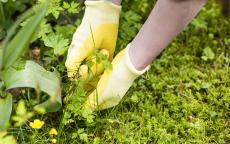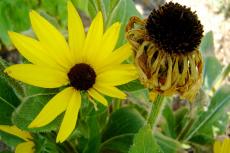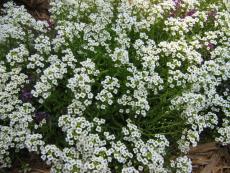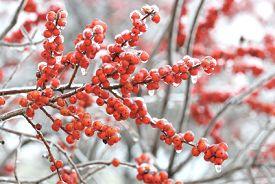You are here
Plant Maintenance Tips
Weed Control 
No one likes to weed! Keeping landscape beds mulched helps to keep weeds to a minimum. It is much easier to pull weeds as you see them than to wait until a bed is overrun. Every few days, check the gardens for weeds and pull them as needed. It is easier to pull weeds if the soil is moist.
Sometimes it is necessary to use a chemical weed control. There are three types of herbicides (weed killers): pre-emergent, selective, and non-selective.
Pre-emergent herbicides (like Preen “Weed Prevent”) prevent new seeds from germinating. This goes for all types of seeds, so this herbicide falls under the non-selective category also. This granular product can be sprinkled in mulched landscape beds. Kingdom Landscaping uses this product in all landscape installations. It does not eliminate weeding entirely, but it does help you lessen the frequency of weeding.
Selective herbicides (like Weed B Gon) kill only the weeds listed on their label. If the weed you need to kill is not listed on the label, the herbicide will not work. Most selective herbicides kill broad-leafed weeds such as dandelions and clover. These herbicides should only be applied to the lawn and are not intended for use in landscape beds.
Non-selective herbicides (like Roundup) will kill any vegetation that it is sprayed onto. It is important to follow the label instructions carefully to avoid accidental killing of landscape plants. These herbicides work well to control weeds in driveway and patio cracks.
Deadheading 
Gardens always look perfect in June. The days are warm, not yet too hot and the spring rains have worked their magic. Perennials are fully up and the annuals are established and blooming profusely. It’s amazing, however, how quickly the "perfect" garden can fall into shabbiness come the first really hot and humid week of July. Unfortunately this usually the time when the weeds take over with a vengeance!
Deadheading is the removal of spent and faded blossoms - pinching back and cutting back are the gardener’s essential tools to recreate the splendor of June throughout the entire summer. These different methods of plant grooming are easy to do, but it is important to know when, how and what to cut.
Why deadhead? 
There is nothing attractive about limp, brown flowers. Deadheading alone will instantly make the garden look better. Many perennials will rebloom if their developing seedpods are removed quickly. While the second blooming is never as bountiful as the first, the prolonged color in the garden is well worth the effort. Some flowers, such as cleome, seed profusely, thus creating a potential "flower weed" problem. (Remember the definition of a weed is "any undesirable in the garden.")
The best time to deadhead is just before or immediately after the flower has faded. If the flower blooms on a single individual stem, such as a geranium, cut the stem off at the place where it meets the plant. Do not merely cut off the dead flower. Annual flowers that respond particularly well to deadheading include: marigolds, geraniums, zinnias, cosmos, salvia and snapdragons.
Pinching Back 
Some annuals have a tendency to get "leggy" with long stems and just a few flowers on the ends. Petunias are a prime example. To encourage a more compact plant and increased flowering, cut the stems back by one-third to one-half. While this process may remove the only flowers on the plant, it will only take a few weeks of growth to have fuller, more plentiful flowering plants.
For some plants, it is desirable to prevent or delay flowering. Basil and coleus, for example, are grown for their leaves and need to be pinched back to prevent flowering, thus encouraging full bushy plants. Many varieties of sedum and chrysanthemum are planted for fall color; however, if the flower buds are not pinched frequently until early July, the plant will bloom in the spring instead of the fall.
Cutting Back 
If an annual or perennial plant is looking particularly peaked in the summer heat, you may want to cut it way back – in half or to the ground. Annuals such as alyssum and lobelia may start to brown if the temperatures get too hot. It is best to cut annuals in half and wait for cooler temperatures to encourage new growth. Fertilize with a water-soluble plant food such as Miracle Gro to quicken the growing process.
If a perennial plant withers in the summer heat, cut it back to the ground. It may not come back until next spring (bleeding hearts and peonies are examples) or it may produce new leaves and maybe even reflower this year (such as salvia and veronica). Each year may produce different results, but removing unsightly plants will instantly make the garden look better.
Preparing Plants for Winter
 The effects of winter damage are often slow to appear. Plants may seem to have come through tough weather, but as spring approaches the edges of leaves turn brown and bark may split, leading to the death of a branch or even the death of the whole plant. The cause of this type of damage is temperature fluctuation. If the temperatures stay cold, plants go dormant. During this dormant period plants do not take in moisture or transpire (transpiration is the act of moisture leaving plants through its leaves). However, in our area we often have cold snaps followed by warm, sunny days. With these warm days, leaves may begin to transpire, but roots, still in frozen ground, are unable to replace life-sustaining moisture. Under these conditions, plants easily become dehydrated.
The effects of winter damage are often slow to appear. Plants may seem to have come through tough weather, but as spring approaches the edges of leaves turn brown and bark may split, leading to the death of a branch or even the death of the whole plant. The cause of this type of damage is temperature fluctuation. If the temperatures stay cold, plants go dormant. During this dormant period plants do not take in moisture or transpire (transpiration is the act of moisture leaving plants through its leaves). However, in our area we often have cold snaps followed by warm, sunny days. With these warm days, leaves may begin to transpire, but roots, still in frozen ground, are unable to replace life-sustaining moisture. Under these conditions, plants easily become dehydrated.
The types of plants that are most likely to suffer from winter damage include broadleaf evergreens (evergreens with leaves instead of needles such as hollies, rhododendrons and laurels), Leyland cypress and Serbian spruce.
There are easy steps to take to prevent or minimize this problem.
- Make sure plants are healthy going into winter. Keep plants well watered, especially during dry summers and autumns.
- Spray Wilt-Pruf on the foliage of broadleaf evergreens. This will provide a barrier, keeping moisture from transpiring. You must spray both sides of leaves and the solution must be applied on a warm day so the Wilt-Pruf can dry correctly.
- If plants are exposed to winter winds, create a windbreak. One of the easiest and best windbreaks is constructed of burlap stapled to wooden stakes driven into the ground. This windscreen will provide protection while letting plants breath.
- Gently brush snow from the branches of boxwood, arborvitae, Japanese maples because these plants' branches may break under the weight.
- Do not attempt to remove ice from any plant. You will do more harm than good.
